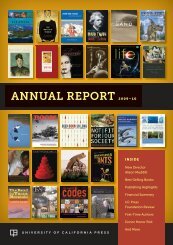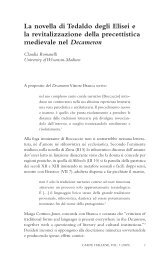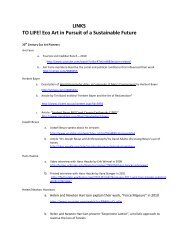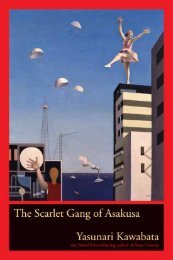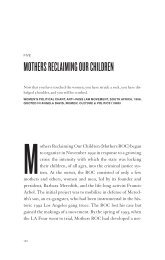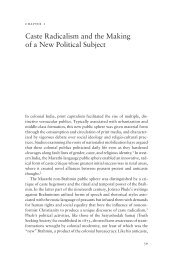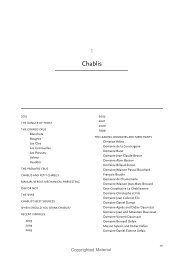Read Chapter 1 (PDF) - University of California Press
Read Chapter 1 (PDF) - University of California Press
Read Chapter 1 (PDF) - University of California Press
You also want an ePaper? Increase the reach of your titles
YUMPU automatically turns print PDFs into web optimized ePapers that Google loves.
east harlem 7<br />
A few blocks north <strong>of</strong> the two museums, a small brick plaza redirects<br />
traffic around the corner <strong>of</strong> Fifth Avenue and 110th Street. Lifted high<br />
above the street on a platform supported by figures <strong>of</strong> nude women,<br />
Duke Ellington stands regally next to a baby grand piano. The monument<br />
anchors the southwest corner <strong>of</strong> Central Harlem, the capital <strong>of</strong><br />
Black America, where Duke Ellington reigned as most influential musician.<br />
But Duke does not face Harlem. He gazes across the other half <strong>of</strong><br />
that traffic circle, which remains starkly empty <strong>of</strong> any similar memorial,<br />
into East Harlem. When Tito Puente died just three years after the installation<br />
<strong>of</strong> the Duke Ellington statue, Puerto Ricans were quick to rename<br />
110th Street Tito Puente Way, and plans were set in motion to erect a<br />
statue, facing Duke, <strong>of</strong> Tito and his timbales.<br />
A few blocks east, past the trestle <strong>of</strong> the Metro North railway at Park<br />
Avenue, is the intersection <strong>of</strong> 110th Street and Lexington Avenue, perhaps<br />
the most infamous corner in East Harlem. In the 1980s this was the<br />
epicenter <strong>of</strong> the crack cocaine catastrophe that rocked New York City.<br />
Made infamous by Philippe Bourgois’s book In Search <strong>of</strong> Respect, the corner<br />
has long been known by locals as a haunt for drug dealers and violence.<br />
Even the post <strong>of</strong>fice located at the intersection seems to echo this<br />
mystique with the ominous “Hell Gate Station” emblazoned above its<br />
entrance.<br />
Since the beginning <strong>of</strong> the 1990s, the intersection <strong>of</strong> 110th and Lexington<br />
has made a slow climb out <strong>of</strong> disrepute. Thanks in part to an improved<br />
economy and more effective policing, the area has witnessed a few more<br />
<strong>of</strong> its abandoned buildings–cum–crack houses transformed into restaurants,<br />
grocery stores, and bodegas. Even the public library on 110th got a<br />
much-needed face-lift. Though drugs now change hands out <strong>of</strong> sight for<br />
the most part, the corner remains a constant reminder that East Harlem is<br />
a few subway stops and a world away from the rest <strong>of</strong> Manhattan.<br />
Up the narrow canyon <strong>of</strong> Lexington Avenue, the thick odor <strong>of</strong> deepfried<br />
food fills the air. Local cuchifritos entice pedestrians with greasy clear<br />
plastic facades filled with stacks <strong>of</strong> deep-fried fare distinguished only<br />
by size and shape. Chinese restaurants, most no wider than the door itself,<br />
serve up lo mein, chicken wings, and fried plantains to go, trying<br />
to keep up with the tastes <strong>of</strong> the neighborhood. And there is the ever-



